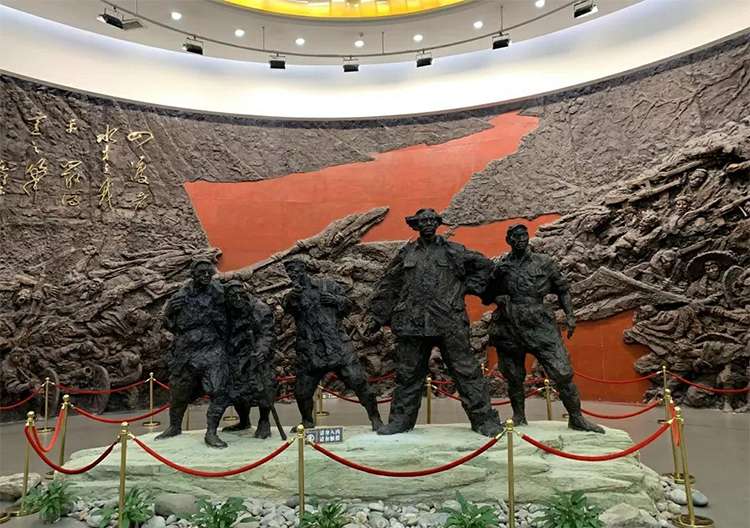Explore Red Army History at Chishui’s Four Crossings Memorial Museum
Introduction
On the banks of the Chishui River in Xishui (Xishui) County, Guizhou, a building that blends northern Guizhou vernacular architecture with modern aesthetics stands quietly: the Four Crossings of Chishui Memorial Museum. Step inside and you are transported back to 1935, to the decisive and dramatic Long March maneuver known as the “Four Crossings of the Chishui.” Mao Zedong called it his “proudest stroke of strategy.” The museum uses original artifacts, realistic scene reconstructions, and multimedia to bring this episode vividly to life. Whether you are a history buff, a military enthusiast, or a traveler seeking China’s revolutionary heritage, this site promises a powerful, memorable experience.
1. Core features and positioning
The Four Crossings of Chishui Memorial Museum is one of China’s most representative Long March-themed museums. Through immersive storytelling and carefully preserved artifacts, it reconstructs a classic case of “defeating a superior force with clever strategy.” More than a museum, it serves as a national patriotic education base and a model national defense education site, drawing visitors who wish to learn from the courage and wisdom of the revolutionaries.
2. Architecture and history: a modern monument to red memory
Opened in 2007 and covering 7,710 square meters, the museum’s design marries the sloped roofs and timber details of northern Guizhou dwellings with the clean lines of contemporary exhibition halls. This sensitive blend earned the building the industry’s top honor, the Luban Award.
Why is the museum located in Tucheng town, Xishui County?
This area was one of the key battlefields during the Four Crossings of the Chishui campaign. The Red Army maneuvered against enemy forces here and ultimately broke through encirclements. The site was chosen not only to commemorate the event but also to keep alive the memory of those hard, heroic years.
3. Key exhibits and immersive experiences
(1) Over 300 precious artifacts: touch the temperature of history
The collection includes more than 300 items from the Long March era—firearms, uniforms, documents, and daily objects—each carrying a weighty historical story. Highlights include:
– Rifles and grenades used by Red Army soldiers: worn but powerful witnesses to determined combat under extreme disadvantage.
– Mao Zedong’s handwritten operational orders: clear script that reveals strategic thinking.
– Soldiers’ straw sandals and patched cotton coats: tangible reminders of the harsh conditions the troops endured.
(2) 3D film theater: a dynamic reconstruction of the campaign
The museum’s 3D theater uses modern technology to recreate pivotal moments of the Four Crossings. Viewers feel immersed in the action—witnessing feints, flanking maneuvers, and daring river crossings that allowed the Red Army to break enemy encirclements.
(3) Scene reconstructions: step into history
– Chishui River ferry scene: a lifelike re-creation of the tense crossing, complete with ambient river sounds.
– Command post reconstruction: scenes evoke Mao Zedong, Zhou Enlai, and other leaders planning and directing operations in close quarters.

4. Visiting tips: how to tour efficiently
(1) Recommended routes
– Highlights express (1 hour): Entrance → Central exhibition hall (key artifacts) → 3D theater → Chishui River crossing scene → Exit.
– Deep immersion (2–3 hours): Visit every hall in chronological order and fully interact with multimedia displays.
(2) Who will enjoy it
– History enthusiasts: for detailed study of the Long March.
– Military historians and strategy fans: to analyze Mao’s tactics.
– Families: a place for patriotic education for children.
– Red tourism groups: experience revolutionary spirit as a group.
(3) Nearby combinations
– Tucheng Ancient Town (within walking distance): well-preserved Ming and Qing architecture and local customs.
– Chishui Danxia Scenic Area (about 1 hour by car): a UNESCO-listed natural wonder of red sandstone landforms.
5. Practical information: what to know before you go
(1) Opening hours and admission
– Hours: 9:00–17:00 (last entry 16:30). Closed on Mondays except public holidays.
– Admission: Free (ID required).
(2) Getting there
– Public transport: Take a long-distance bus from Zunyi city to Xishui County, then a local bus or taxi.
– Driving: Set your navigator to “Four Crossings of Chishui Memorial Museum.” On-site parking is available.
(3) Guides and services
– Audio guides (including English).
– Scheduled guided talks (primarily Chinese; English guides available by advance request).
(4) Visitor reminders
– Flash photography is prohibited to protect artifacts.
– Wear comfortable shoes—some walking is required.
6. Local tips: hidden ways to enhance your visit
– Visit at dawn or dusk for fewer crowds and a more solemn atmosphere.
– Walk the Chishui riverside outside the museum for quiet reflection amid nature and history.

Conclusion: a moving historical journey
The Four Crossings of Chishui Memorial Museum is more than a collection of objects—it is a monument to spirit. Here you can feel the Red Army’s resilience and ingenuity and grasp the sweeping significance of China’s revolutionary past. If your itinerary includes red tourism in Guizhou, this museum is an essential stop.
“Four crossings of the Chishui were unexpected maneuvers; Chairman Mao’s military art was almost divine.” Step inside the museum and discover the story behind that famous line.


